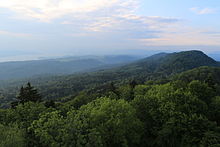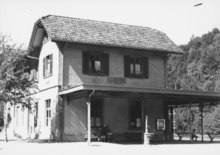Sihlwald
The Sihlwald is a roughly 12 km² Swiss nature reserve and is part of the Zurich Wilderness Park . Since January 1st, 2009 it has been the first nationally recognized nature adventure park in Switzerland . Although the Sihlwald in the Sihltal on the eastern flank of the Albis has been claimed by the city of Zurich for over 700 years , it is located in the municipal areas of Adliswil , Langnau am Albis , Horgen , Oberrieden ZH , Rüschlikon and Thalwil .
Together with the surrounding forests, the Sihlwald forms the largest natural, contiguous mixed deciduous forest in the densely populated Swiss Plateau . The most common tree species (with 39%) is the common beech ( Fagus silvatica ), which provides wood with a high calorific value. In addition, there are spruce trees brought in by humans (25%) and the autochthonous tree species silver fir , ash , yew , pine , sycamore maple and sycamore elm .
Zurich city forest
So far it has been assumed that in 1309 the Sihlwald to the left of the Sihl came to the city of Zurich as a gift from the Habsburgs . This in return for the fact that Zurich behaved neutrally in the Habsburg vengeance against the Barons von Eschenbach , who were involved in the murder of King Albrecht . In 1987, as part of an extensive study by the historian Margrit Irniger, this representation could neither be denied nor confirmed because no credible archival material was found.
After the relocation of the Habsburg rulership center from the ancestral castle Habsburg in Switzerland to Austria in the 13th century and later with the decline of the Eschenbach monastery in Kappel , the feudal monopoly of power in the area of the Sihlwald and its surroundings fell apart. The city of Zurich had a free hand and was not dependent on a "donation". Rather, the city has appropriated the Sihlwald to the left of the Sihl over the centuries by making the farmers who are customarily used for cattle, wood and other uses in what is now the forest area, compulsory for a fee and making them dependent on them so that they can secure the wood deliveries to Zurich. From these service obligations in favor of the city, a city-Zurich property was derived over the centuries, largely without discoverable legal acts, but hardly with predominant disadvantages for the local farmers. After the Fraumünster Monastery was dissolved, the forest on the right of the Sihl also came into the possession of the city in 1524. It was not until the 19th century that the remaining peasant usage rights in the Sihlwald were replaced by Orelli, the first city forester from Zurich, CA.
Use of wood
The Sihlamt was established in 1424 as the competent authority for timber use, rafting and timber trade. The Sihlherr as Superintendent were under four Sihlwaldmeister who had to manage the forest. The most famous Sihl lord Salomon Gessner was in office from 1781–1788, in the summer in the old Sihlwald forester's house from 1733.
The name Zimmerberg , on the slope of which lies the forest to the right of the Sihl, still shows the connection to the Old High German word zimbar , which means something like "timber".
The forest served as the most important supplier of wood for the city of Zurich, which had a great need for construction and firewood . The wood was initially used as clear cutting , later as umbrella cutting . By the 17th century at the latest, the entire Sihlwald was managed according to regulated forestry techniques. The young generation of trees was able to develop under the umbrella of a limited number of old trees, which made the Sihlwald a role model that is well known beyond Switzerland.
From the middle of the 18th century at the latest, attempts were made to limit the use of wood in terms of quantity, which embodied the beginning of sustainable forestry. In 1864, a factory with around 100 employees was set up, including houses, school and post office. In addition to the processing of firewood, telephone poles, boards, handles for tools and wood wool were produced. In 1991 the woodworking factory was shut down.
Full sustainability was only achieved in the middle of the 20th century. The city's need for wood had previously regularly led to overuse. It was not until hard coal became affordable as a fuel in Switzerland - around 1920 - that firewood began to lose its importance. The wood growth has been over 10 m 3 / ha and year since 1990 . It may increase even more.
In 2016, the Sihlwald had an estimated solid wood supply of over 550 m 3 / ha, a good three times more than at the end of the 19th century. The wood supply of standing trees and lying dead wood will begin to level off in the long term at 800 - 1000 m 3 / ha with a small-scale primeval forest structure in around 250 years , as comparisons with European mixed primeval beech forests suggest. The Sihlwald is one of the fastest growing and most fertile forest locations in Central Europe . Beechnuts have been exported as tree seeds to many European countries. Carbon extracted from the air by photosynthesis in trees and conserved as biomass in the Sihlwald is a contribution to climate protection ; estimated from about 6,000 to 10,000 tons of CO 2 per year over the next two centuries.
Timber transport
When the snow melted, the wood on the Sihl was washed into the city of Zurich as a drift . The rafting on the Sihl was given up in 1866. The standard gauge Sihl Valley Railway and the new country road from 1856 were the main routes for transporting wood into the city. From 1876 to 1938 a forest railway facilitated the management. The length of the fixed tracks was 12 kilometers, and temporary, “flying” tracks were laid as required.
Sihlwald natural landscape
In 1985 the foundation stone for the "Sihlwald Natural Landscape" project was laid on the initiative of city forest manager Andreas Speich. From 1985, under his direction, up to 18,000 m 3 of wood per year were removed from the Sihlwald in a targeted manner - exclusively as thinning to introduce a natural forest structure. Since 1996, except for safety reasons, no more wood has been felled along the paths. This gradually creates a stable natural forest that is left to its own devices and regulates itself. The creation of this large forest reserve had, however, led to intrigues and bitter resistance from forestry experts up to the highest federal authorities. In contrast, the Swiss forest scientist who previously taught at the ETH Zurich, a forestry farmer known throughout Europe and Prof. Dr. Emeritus in 1979. Dr. hc. mult. Hans Leibundgut - he was considered a pioneer of European jungle research - emphatically supports the creation of the reserve.
The artificial and unnatural young forest stands of the same age in the Sihlwald remain a risk for the time being if, as in 1885, an extraordinary wet snowfall breaks the young trees or bends them to the ground. Such events and extensive wind throws have been very rare since 1985, but could occur again. However, the risk is steadily decreasing because the increasing, "anchoring" root mass makes the trees more stable.
In 1994 the Sihlwald Natural Landscape Foundation set itself the goal of turning the Sihlwald into a natural experience space. The trees and other forest creatures have their own right to live, which from now on should be vigorously respected in the Sihlwald. In 2009 a core zone of around 4 km² was established in which nature remains untouched. Entering this area is prohibited and visitors must stay on the paths.
Today the Sihlwald is part of the “Wilderness Park Zurich Foundation”.
traffic
The Sihlwald stop is served by the Zurich S-Bahn with the S 4 Zurich HB - Adliswil - Langnau-Gattikon (- Sihlwald ).
gallery
Web links
- www.wildnispark.ch
- www.sihlwaldfueralle.ch
- Stadtforstamt Zürich, Sihlwald. Images from 1870, on the Zurich City Archives website
- Sihlwald Forestry 1913: Sihlwald Forest Railway Video on YouTube
Individual evidence
- ↑ stadt-zuerich.ch: Wildnispark Zuerich - City of Zurich , accessed on February 4, 2011.
- ↑ Horgen year Issue 1983: Sihlwald
- ^ Johann Andreas Schmeller: Old High German Zimbar In: Bavarian Dictionary. Oldenbourg 2008.
- ↑ Discontinued railways: Waldbahn Sihlwald
- ^ ZKB (Ed.): Zürcher Wirtschaftsmagazin 4/2010; P. 10 ff.
Coordinates: 47 ° 16'7 " N , 8 ° 33'24" E ; CH1903: six hundred and eighty-four thousand six hundred and two / 235907 .










